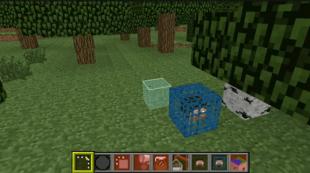The structural elements of the protozoa do not belong. Organelles of movement: functions and structure, features of the movement of protozoa. The structure and function of the organelles of movement
Body the simplest consists of cytoplasm and one or more cores. The nucleus is surrounded by a double membrane and contains chromatin, which includes deaxyribonucleic acid (DNA), which determines the genetic information of the cell. Most protozoa have a vesicular nucleus with a small amount of chromatin collected along the periphery of the nucleus or in the intranuclear body, the karyosome. Micronuclei of ciliates are massive nuclei with big amount chromatin. Common cell components of most protozoa include mitochondria and the Golgi apparatus.
Surface bodies of amoeboid forms(sarcodes, as well as some stages of the life cycle of other groups) is dressed with a cell membrane about 100 A. The body of many flagellates is covered with a periplast formed by a series of longitudinal fibrils fused with a pellicle. Many protozoa have special supporting fibrils, such as the supporting fibril of the undulating membrane in trypanosomes and Trichomonas.
Tight and rigid casings have resting forms of protozoa, cysts. Shell amoebas, foraminifera, and some other protozoa are enclosed in houses or shells.
Unlike cells of a multicellular organism the protozoan cell is an integral organism. Structural formations and organelles can be specialized to perform various functions of the organism in the body of the simplest. According to their purpose, the organelles of protozoa are divided into organelles of movement, nutrition, excretion, etc.
Very varied organelles of protozoa movement... Amoeboid forms move through the formation of protrusions of the cytoplasm, pseudopodia. This type of movement is called amoeba, and is found in many groups of protozoa (sarcodes, asexual forms of sporozoans, etc.). Flagella and cilia serve as special organelles of movement. Flagella are characteristic of the class of flagellates, as well as gametes of representatives of other classes. They are few in most forms (from 1 to 8). The number of cilia, which are organelles of the movement of ciliates, can reach several thousand in one individual. Electron microscopic studies have shown that flagella and cilia in Protozoa, Metazoa, and plant cells are built according to the same type. They are based on a bundle of fibrils, consisting of two central and nine paired, peripheral.
Harness surrounded by a shell which is a continuation cell membrane... Central fibrils are present only in the free part of the cord, and peripheral ones penetrate deep into the cytoplasm, forming a basal granule - blepharoplast. The tourniquet can be connected to the cytoplasm over a considerable length by a thin membrane - the undulating membrane. The ciliary apparatus of ciliates can reach considerable complexity and differentiate into zones that perform independent functions. Cilia often fuse in groups to form spines and membranella. Each cilium starts from a basal grain, a kinetosome, which lies in the surface layer of the cytoplasm. The set of kinetosomes forms the infrastructure. Knnetosomes are reproduced only by dividing in two and cannot arise anew. With a partial or complete reduction of the flagellar apparatus, the infrastructure remains and subsequently gives rise to new cilia.
Divides all cells (or living organisms) into two types: prokaryotes and eukaryotes... Prokaryotes are non-nuclear cells or organisms, which include viruses, prokaryotic bacteria and blue-green algae, in which the cell consists directly of the cytoplasm, in which one chromosome is located - DNA molecule(sometimes RNA).
Eukaryotic cells have a nucleus in which there are nucleoproteins (histone protein + DNA complex), as well as others organelles... Eukaryotes include the majority of modern single-celled and multicellular living organisms (including plants) known to science.
The structure of eukaryotic oranoids.
|
Organoid name |
Organoid structure |
Organoid functions |
|---|---|---|
|
Cytoplasm |
The internal environment of the cell, which contains the nucleus and other organelles. It has a semi-liquid, fine-grained structure. |
|
|
Ribosomes |
Small spherical or ellipsoidal organelles with a diameter of 15 to 30 nanometers. |
Provide the process of synthesis of protein molecules, their assembly from amino acids. |
|
Mitochondria |
Organoids, which have a wide variety of shapes - from spherical to filamentous. Inside the mitochondria, there are folds from 0.2 to 0.7 microns. The outer shell of mitochondria has a two-membrane structure. The outer membrane is smooth, and on the inner there are outgrowths of the cruciform different shapes with respiratory enzymes. |
|
|
Endoplasmic reticulum (EPS) |
A system of membranes in the cytoplasm that forms channels and cavities. There are two types: granular, on which there are ribosomes and smooth. |
|
|
Plastids(organelles characteristic only of plant cells) are of three types: |
Double membrane organelles |
|
|
Leukoplasts |
Colorless plastids found in tubers, roots and plant bulbs. |
They are an additional reservoir for storing nutrients. |
|
Chloroplasts |
Organoids are oval in shape and have a green color. They are separated from the cytoplasm by two three-layer membranes. Chlorophyll is found inside the chloroplasts. |
Transform organic matter from inorganic, using the energy of the sun. |
|
Chromoplasts |
Organoids, from yellow to brown in color, in which carotene accumulates. |
Contribute to the appearance in plants of parts with yellow, orange and red color. |
|
Lysosomes |
Organoids are round in shape with a diameter of about 1 micron, having a membrane on the surface, and a complex of enzymes inside. |
Digestive function. They digest nutrient particles and eliminate dead cells. |
|
Golgi complex |
It can be of different shapes. Consists of cavities delimited by membranes. Tubular formations with bubbles at the ends depart from the cavities. |
|
|
Cell center |
It consists of a centrosphere (a compacted area of the cytoplasm) and centrioles - two small bodies. |
Serves an important function for cell division. |
|
Cell inclusions |
Carbohydrates, fats and proteins, which are fickle components of the cell. |
Reserve nutrients that are used for the life of the cell. |
|
Organelles of movement |
Flagella and cilia (outgrowths and cells), myofibrils (filamentous formations) and pseudopodia (or pseudopods). |
They perform a motor function, as well as provide the process of muscle contraction. |
Cell nucleus is the main and most complex organelle of the cell, so we will consider it
Each flagellum is outside covered with a three-layer cytoplasmic membrane. There are fibrils inside the flagellum: two central and nine double peripheral. The flagellum is attached in the cytoplasm with the help of the basal body - the kinetosome. Usually, the flagella produce a rotating motion, and the cilia produce a rowing motion. Flagella are characteristic of flagellates, and cilia are characteristic of ciliates.
Some protozoa are capable of rapid body contraction due to special contractile fibrils - myonemes. For example, sessile suvoy ciliates are able to sharply contract their long stalk and fold it into a spiral. Radiolarians are able to stretch the cell body on radial needles, then to contract it due to contractile fibers. This provides them with the regulation of free swimming in the water column.
SUBDIVIDANCE OF THE SIMPLE, OR SINGLE-CELLULAR (PROTOZOA)
Motor organelles.
The most primitive way of movement in protozoa can be considered amoeboid movement with the help of false legs, or pseudopodia. In this case, special protrusions of the cell are formed, into which the cytoplasm flows. Such organelles of movement are inherent in unicellular ones with a fickle body shape.
More complex movement characteristic of the simplest, which have the movement of flagella or cilia as organelles. The structure of the flagellum and cilia is similar.
The type of protozoa includes about 25 thousand species of unicellular animals that live in water, soil, or the organisms of other animals and humans. Having morphological similarity in the structure of cells with multicellular organisms, protozoa differ significantly from them in functional terms.
If the cells of a multicellular animal perform special functions, then the cell of a protozoan is an independent organism capable of metabolism, irritability, movement and reproduction.
The simplest are organisms at the cellular level of organization. In morphological terms, the simplest is equivalent to a cell, but physiologically it is a whole independent organism. The overwhelming majority of them are microscopically small (from 2 to 150 microns). However, some of the living protozoa reach 1 cm, and the shells of a number of fossil rhizopods are up to 5-6 cm in diameter.The total number of known species exceeds 25 thousand.
The structure of the simplest is extremely diverse, but they all have features characteristic of the organization and function of the cell. Common in the structure of the structure of the protozoa are two main components of the body - the cytoplasm and the nucleus.

Cytaplasm
The cytoplasm is limited by the outer membrane, which regulates the entry of substances into the cell. In many of the simplest, it is complicated by additional structures that increase the thickness and mechanical strength of the outer layer. Thus, formations such as pellicle and shell arise.
The cytoplasm of protozoa usually splits into 2 layers - the outer one is lighter and denser - ectoplasm and internal, equipped with numerous inclusions, - endoplasm.
General cellular organelles are localized in the cytoplasm. In addition, a variety of special organelles can be present in the cytoplasm of many protozoa. Various fibrillar formations are especially widespread - supporting and contractile fibers, contractile vacuoles, digestive vacuoles, etc.
Core
Protozoa have a typical cell nucleus, one or more. The nucleus of the protozoa has a typical two-layer nuclear envelope. Chromatin material and nucleoli are distributed in the nucleus. The nuclei of protozoa are characterized by exceptional morphological diversity in size, the number of nucleoli, the amount of nuclear juice, etc.
Features of the life of protozoa
Unlike somatic cells, multicellular protozoa are characterized by the presence of a life cycle. It is composed of a series of successive stages, which in the existence of each species are repeated with a certain regularity.
Most often, the cycle begins with the zygote stage corresponding to the fertilized egg of multicellular organisms. This stage is followed by single or multiple repeated asexual reproduction, carried out by cell division. Then sex cells (gametes) are formed, the pairwise fusion of which again gives a zygote.
An important biological feature of many protozoa is the ability to encysting. At the same time, the animals are rounded, discard or draw in the organelles of movement, emit a dense shell on their surface and fall into a state of rest. In an encystated state, protozoa can undergo drastic changes. environment while maintaining vitality. When conditions favorable for life return, cysts open and protozoa emerge from them in the form of active, mobile individuals.
According to the structure of the organelles of movement and the characteristics of reproduction, the type of protozoa is divided into 6 classes. The main 4 classes are Sarcodes, Flagellates, Sporozoans and Infusoria.
Organella is a permanent formation in the cell that performs certain functions. They are also called organelles. Organella is what allows the cell to live. Just as animals and humans are made up of organs, so every cell is made up of organelles. They are diverse and perform all the functions that ensure the life of the cell: this is metabolism, and their storage, and division.
What are organelles?
Organella is a complex structure. Some of them may even have their own DNA and RNA. All cells contain mitochondria, ribosomes, lysosomes, cell center, Golgi apparatus (complex), endoplasmic reticulum (reticulum). Plants also have specific cellular organelles: vacuoles and plastids. Some also classify microtubules and microfilaments as organelles.
The organelle is a ribosome, a vacuole, a cell center, and many others. Let's take a closer look at the structure and function of organelles.
Mitochondria
These organelles provide the cell with energy - they are responsible for They are found in plants, animals, and fungi. These cell organelles have two membranes: external and internal, between which there is an intermembrane space. What is inside the shells is called the matrix. It contains a variety of enzymes - substances necessary to accelerate chemical reactions. The inner membrane has folds - cristae. It is on them that the process of cellular respiration takes place. In addition, the mitochondrial matrix contains mitochondrial DNA (mDNA) and mRNA, as well as ribosomes, which are almost similar to those possessed by
Ribosome
This organoid is responsible for the translation process, in which protein is synthesized from individual amino acids. The structure of the organelle of the ribosome is simpler than that of mitochondria - it does not have membranes. This organoid consists of two parts (subunits) - small and large. When the ribosome is inactive, they are separate, and when it begins to synthesize protein, they combine. Several ribosomes can also come together if the polypeptide chain synthesized by them is very long. This structure is called a "polyribosome".

Lysosomes
The functions of this type of organelles are reduced to the implementation of cellular digestion. Lysosomes have one membrane, inside which there are enzymes - catalysts for chemical reactions. Sometimes these organelles not only break down but also digest whole organelles. This can occur during a prolonged hunger strike of the cell and allows it to live for some more time. However, if nutrients still do not begin to flow, the cell will die.

and functions
This organelle consists of two parts - centrioles. These are formations in the form of cylinders, consisting of microtubules. The cell center is a very important organoid. He participates in the formation of the fission spindle. In addition, it is the center of microtubule organization.
Golgi apparatus
It is a complex of disc-shaped membrane sacs called cisternae. The functions of this organoid are to sort, store and transform certain substances. Mainly carbohydrates are synthesized here, which are part of the glycocalyx.

The structure and function of the endoplasmic reticulum
It is a network of tubes and pockets surrounded by a single membrane. There are two types of endoplasmic reticulum: smooth and rough. Ribosomes are located on the surface of the latter. The smooth and rough reticula serve different functions. The first is responsible for the synthesis of hormones, storage and conversion of carbohydrates. In addition, the rudiments of vacuoles - organelles characteristic of plant cells - are formed in it. The rough endoplasmic reticulum contains ribosomes on its surface, which produce a polypeptide chain from amino acids. Then she falls into endoplasmic reticulum, and here a certain secondary, tertiary and quaternary structure of the protein is formed (the chain is twisted in the correct way).

Vacuoles
These are organelles. They have one membrane. They accumulate cell juice. The vacuole is necessary to maintain turgor. She also participates in the process of osmosis. In addition, there are They are found mainly in unicellular organisms living in water bodies, and serve as pumps that pump out excess fluid from the cell.
Plastids: varieties, structure and function
They are also organelles. They are of three types: leukoplasts, chromoplasts, and chloroplasts. The former are used to store reserve nutrients, mainly starch. Chromoplasts contain various pigments. Thanks to them, the petals of plants are multi-colored. The body needs this primarily in order to attract pollinating insects.
Chloroplasts are the most important plastids. Most of them are found in the leaves and stems of plants. They are responsible for photosynthesis - a chain of chemical reactions, during which the body gets organic from inorganic substances. These organelles have two membranes. The chloroplast matrix is called the "stroma". It contains plastid DNA, RNA, enzymes, and starch inclusions. Chloroplasts contain thylakoids - membrane formations in the form of a coin. Photosynthesis takes place inside them. It also contains chlorophyll, which serves as a catalyst for chemical reactions. Chloroplast thylakoids are combined into stacks - grana. Also in the organelles are lamellae, which connect the individual thylakoids to each other and provide a connection between them.
Organelle movement
They are characteristic mainly of unicellular organisms. These include flagella and cilia. The former are present in euglena, trypanosomes, and chlamydomonas. Flagella are also present in animal sperm. Cilia are found in ciliates and other unicellular organisms.
Microtubules
They provide the transport of substances, as well as the constant shape of the cell. Some scientists do not classify microtubules as organelles.









